Terrariums are just miniature landscapes created in a clear, covered, container. The choice of the container and appearance of the landscape is entirely yours!
What follows is a demonstration that Olive gave in the spring of 2004 to a local garden club that visited the ‘Violet Barn’ for this workshop and outlines the basic steps in creating a terrarium
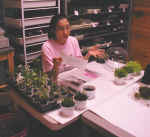
Step #1: Collecting plants and materials.
Nearly anything can be grown inside a glass container. What makes a good terrarium, however, is a miniature landscape that can be easily maintained to keep its intended appearance. For this reason, it is very important to use only plants that can grow (and not outgrow) within the confines of the container.
Use plants that are naturally small-leaved, don’t grow too quickly, and can easily be maintained. Using these plants allows you to keep the original appearance of the landscape for a longer period of time, with a minimum of effort. All of the “miniature houseplants” offered through this web-site are suitable for this purpose.
Don’t use large, fast-growing plant material that is “cut down” to a size to fit into the container. They’ll soon overwhelm slower-growing material planted with it and outgrow the container. Also, be careful about using too many blooming plants, or plants that easily shed their leaves. Old blooms and leaves will more quickly decay in the humid atmosphere inside a terrarium.
The choice of container is yours. Any clear, waterproof, container will do. Anything from a fine piece of crystal to an old mayonnaise jar. Unless you are adept at using tweezers, choose a container with a large enough opening for your hand–this will make planting and maintaining your terrarium easier.
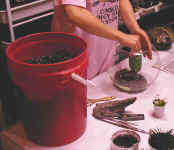
Step #2: Add drainage material and soil.
Since your container is not likely to have drainage holes in the bottom, it’s important to have a place for excess water to collect, so that plant material doesn’t become overwatered. One way to provide this is to put a thin layer of perlite or horticultural charcoal in the bottom of the container. These materials will absorb little water and will provide good drainage. Charcoal has the advantage of being black (less visible) and freshens the soil in the container.
After the layer of drainage material is placed in the bottom, you can add your potting mix. Don’t overfill the container. Since you’ll be using small plants with small root systems, it isn’t necessary to have more than a few inches of soil. To create some “depth” to the planting, mound the soil higher one side (usually the back) than the others.
A light, porous, “soilless” (peat-based, no topsoil) mix is better, since too heavy a mix can retain too much water, a more serious problem when growing plants inside a closed container. We use our regular potting mix, a little over 50% of which is perlite and vermiculite. Use soil that has been premoistened (moist, not soggy), since it will be easier to work with. Also, if it’s too wet or too dry, it will be more difficult to keep the plant material and container clean.
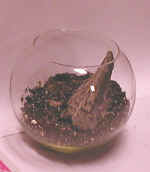
Step #3: Place non-plant material.
Start your landscape by placing your large, non-plant material, like wood or rock into the container. Here, Olive has used a piece of old wood (see “preparing materials” for cleaning and preparation tips). We prefer to use natural materials, since we intend to create miniature view of what we might see in nature.
Like an outside garden, such a piece can act as the “anchor” around which plant material can be placed. This piece also provides some height and scale to the planting, making it more “three dimensional” and providing a background for the plants that will be added.
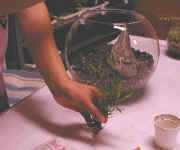
Step #4: Add plant material.
To make planting easier, you can remove much (or most) of the soil and rootball. Pruning the roots of a larger plant will slow their growth and help keep them small. Also, the layer of soil in the container shouldn’t be more than a few inches deep, and won’t accommodate plants with very large root systems.
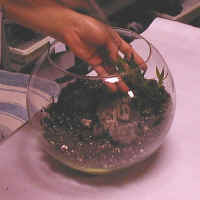
Step #5: Placing plant material.
Add the larger, taller, plant material first–like planting trees and shrubs first in your garden. Use plants of differing heights, shapes, and textures. This is what makes your planting a “landscape” rather than just “plants in a glass jar”.
If getting your hand into the container to place plants is difficult, use long-handled tweezers to make a planting hole and then grasping and placing plants.
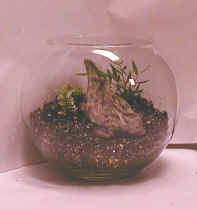
The same principles that apply in landscaping an any garden apply here, in miniature.
Place taller plants, or “trees” from middle to back, use intermediate plants to represent “shrubs”, and smaller, low-growing material as “ground cover”.
Use materials of different colors or textures, either as focal points of the planting, or to highlight (or hide) other materials. Since this is a miniature representation of a natural scene, it isn’t necessary to use artificial or man-made materials or accessories.
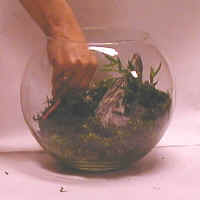
Step #6: Covering the soil.
We like to cover the soil, with either low-growing plants or mosses once all of the plants have been placed. We collect mosses from the woods on our property (see how to prepare them for use), and cut them into pieces that will fit the planting. Shape and press the moss in between the plants and other material. Should you want to add more plants after placing the moss, simply create a hole in the moss and plant into it.
If mosses aren’t available (we can’t collect them in winter), we might use fine (orchid) bark, or other natural, neutral-colored material to cover the soil surface. These mosses will eventually turn brown and die, but even then they look attractive. Should you wish to keep that “green” look, you can easily remove the old moss, or simply place sheets of new moss over the old.
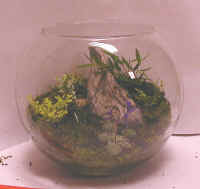
Step #7: The finished terrarium.
Our last step is to place a miniature blooming plant into the planting–which would be necessary to exhibit in many shows. As before, select a miniature plant that won’t outgrow the container, like a miniature violet or other gesneriad (in this case we used a Petrocosmea, the blue-flowered plant in the front). Plants with blue, white, or other pastel colored (not multicolored) blooms are best, since these are the colors one most often sees in nature.
Finally, clean excess debris from the container. Use a small brush to get rid of loose soil stuck on the glass. Small particles of soil can be washed from the plant leaves and wood when you water the planting. Do this gently and carefully. Provide only as much water as the plants need–don’t overwater, especially if you intend to keep the container covered.
Step #8: Maintaining your terrarium.
Place your terrarium in a bright location free of direct (hot) sunlight–the glass can magnify the sunlight and heat will be collected inside, roasting the plants. Artificial light is good for this reason (bright but not hot), though we’ve grown many near (not in) windows. Water when needed, and lightly–rather than pouring water, try “spraying” water into the container.
Trim plants that become overgrown, pinching off tips of too-tall plants, and removing dead or decaying material. To limit plant growth even more, trim the roots, by poking a sharp (modeling) knife into the soil around the plant–this will cut the roots, which will limit the size of the plant. Properly maintained, plantings can be kept attractive for a year or more before replanting.
Give it a try, have fun, and good luck!

Thank you for the simple but ample directions! Can’t wait to get started!